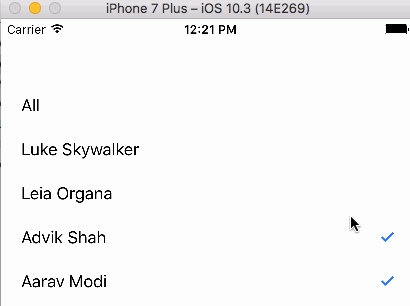Swift 3.0 multiple selection with select all cell
Create a struct for model data with a Bool property. You can modify this property by cell selection.

class ViewController: UIViewController, UITableViewDelegate, UITableViewDataSource {
var allCharacters:[Character] = []
override func viewDidLoad() {
super.viewDidLoad()
allCharacters = [Character(name: "All"),Character(name: "Luke Skywalker"),Character(name: "Leia Organa"),Character(name: "Advik Shah"),Character(name: "Aarav Modi")]
}
func tableView(_ tableView: UITableView, numberOfRowsInSection section: Int) -> Int {
return allCharacters.count
}
func tableView(_ tableView: UITableView, cellForRowAt indexPath: IndexPath) -> UITableViewCell {
var cell = tableView.dequeueReusableCell(withIdentifier: "Cell")
if cell == nil{
cell = UITableViewCell(style: .subtitle, reuseIdentifier: "Cell")
}
cell?.textLabel?.text = allCharacters[indexPath.row].name
if allCharacters[indexPath.row].isSelected
{
cell?.accessoryType = .checkmark
}
else
{
cell?.accessoryType = .none
}
cell?.selectionStyle = .none
return cell!
}
func tableView(_ tableView: UITableView, didSelectRowAt indexPath: IndexPath) {
if indexPath.row == 0
{
allCharacters[indexPath.row].isSelected = !allCharacters[indexPath.row].isSelected
for index in allCharacters.indices
{
allCharacters[index].isSelected = allCharacters[indexPath.row].isSelected
}
}
else
{
allCharacters[indexPath.row].isSelected = !allCharacters[indexPath.row].isSelected
if allCharacters.dropFirst().filter({ $0.isSelected }).count == allCharacters.dropFirst().count
{
allCharacters[0].isSelected = true
}
else
{
allCharacters[0].isSelected = false
}
}
tableView.reloadData()
}
}
struct Character
{
var name:String
// var otherDetails
var isSelected:Bool! = false
init(name:String) {
self.name = name
}
}
Creating Array of Struct objects from array of dictionary
let SubjectArray = json["students"] as! [[String:Any]]
allCharacters = SubjectArray.map({ Character(name: $0["studentName"] as! String) })
allCharacters.insert(Character(name:"All"), at: 0)
I like @Pranil's suggestion of using a separate section for the "All" row, so I have stolen that.
You can use an NSMutableIndexSet for tracking the selected rows. This is simpler than having to create a new struct or array of booleans or something. The only thing you do need to be aware of is if your tableview allows row reordering then the index set needs to be adjusted accordingly.
Here is my implementation. The "all" state is determined by the number of selected rows being equal to the number of rows in the data source array.
I have just used simple table view accessories for the checkmarks, but I am sure you can see how to adopt your image based approach in cellForRow(at:)
import UIKit
class ViewController: UIViewController, UITableViewDataSource, UITableViewDelegate {
@IBOutlet weak var tableview: UITableView!
let names: [String]? = ["Luke Skywalker","Leia Organa","Advik Shah","Aarav Modi"]
var selectedRows = NSMutableIndexSet()
override func viewDidLoad() {
super.viewDidLoad()
// Do any additional setup after loading the view, typically from a nib.
}
override func didReceiveMemoryWarning() {
super.didReceiveMemoryWarning()
// Dispose of any resources that can be recreated.
}
func numberOfSections(in tableView: UITableView) -> Int {
return 2
}
func tableView(_ tableView: UITableView, numberOfRowsInSection section: Int) -> Int {
guard let names = self.names else {
return 0
}
return 0 == section ? 1 : names.count
}
func tableView(_ tableView: UITableView, cellForRowAt indexPath: IndexPath) -> UITableViewCell {
let cell = tableView.dequeueReusableCell(withIdentifier: "tableCell", for: indexPath)
var text: String
var accessory = UITableViewCellAccessoryType.none
if 0 == indexPath.section {
text = "All"
if self.selectedRows.count == self.names!.count {
accessory = .checkmark
}
} else {
text = names![indexPath.row]
if selectedRows.contains(indexPath.row) {
accessory = .checkmark
}
}
cell.textLabel!.text = text
cell.accessoryType = accessory
return cell
}
func tableView(_ tableView: UITableView, willSelectRowAt indexPath: IndexPath) -> IndexPath? {
if indexPath.section == 0 {
if self.selectedRows.count == self.names!.count {
self.selectedRows = NSMutableIndexSet()
} else {
self.selectedRows = NSMutableIndexSet(indexesIn: NSRange(location: 0, length: self.names!.count))
}
tableView.reloadData()
} else {
self.selectedRows.contains(indexPath.row) ? self.selectedRows.remove(indexPath.row) : self.selectedRows.add(indexPath.row)
let rows = [IndexPath(row: 0, section: 0), indexPath]
tableView.reloadRows(at: rows, with: .none)
}
return nil
}
}
I think you are using only one section in the table view. I suggest you use two sections in the table view, so that first section will contain only one row (Select All) and the second section will contain other options. When you click on Select All, that is in the first row of the first section you can make all the rows in the second section as selected while reloading the table view.
// MARK: - struct for cell item
struct CellItem {
var name : String
var isSelected:Bool! = false
init(name: String) {
self.name = name
}
}
class ViewController: UITableViewController {
@IBOutlet var viewTable: UITableView!
// Declare a boolean varaible to toggle the checkbox in the first section of table view
var isSelectAllSelected : Bool = false
var cellData: [CellItem] = []
override func viewDidLoad() {
super.viewDidLoad()
cellData = [CellItem(name: "Luke Skywalker"),CellItem(name: "Leia Organa"),CellItem(name: "Advik Shah"),CellItem(name: "Aarav Modi")]
}
override func didReceiveMemoryWarning() {
super.didReceiveMemoryWarning()
}
// MARK: - Table view data source
override func numberOfSections(in tableView: UITableView) -> Int {
return 2
}
override func tableView(_ tableView: UITableView, numberOfRowsInSection section: Int) -> Int {
if section == 0 {
return 1
}
else
{
return cellData.count
}
}
override func tableView(_ tableView: UITableView, heightForHeaderInSection section: Int) -> CGFloat {
return 0
}
// MARK: - Table view delegates
override func tableView(_ tableView: UITableView, heightForRowAt indexPath: IndexPath) -> CGFloat {
return 60
}
override func tableView(_ tableView: UITableView, cellForRowAt indexPath: IndexPath) -> UITableViewCell{
let cell = TableCell()
cell.selectionStyle = .none
if indexPath.section == 0 {
cell.textLabel?.text = "Select All"
if isSelectAllSelected{
cell.accessoryType = .checkmark
}
else{
cell.accessoryType = .none
}
}
else
{
cell.textLabel?.text = cellData[indexPath.row].name
if cellData[indexPath.row].isSelected{
cell.accessoryType = .checkmark
}
else{
cell.accessoryType = .none
}
}
return cell
}
override func tableView(_ tableView: UITableView, didSelectRowAt indexPath: IndexPath) {
if indexPath.section == 0
{
cellData[indexPath.row].isSelected = !cellData[indexPath.row].isSelected
isSelectAllSelected = cellData[indexPath.row].isSelected
for index in cellData.indices
{
cellData[index].isSelected = cellData[indexPath.row].isSelected
}
}
else
{
cellData[indexPath.row].isSelected = !cellData[indexPath.row].isSelected
if cellData.filter({ $0.isSelected }).count == cellData.count
{
isSelectAllSelected = true
}
else
{
isSelectAllSelected = false
}
}
viewTable.reloadData()
} }